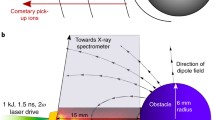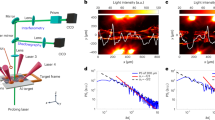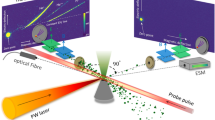Abstract
Magnetic reconnection converts magnetic energy into thermal and kinetic energy in plasma. Among the numerous candidate mechanisms, ion acoustic instabilities driven by the relative drift between ions and electrons (or equivalently, electric current) have been suggested to play a critical role in dissipating magnetic energy in collisionless plasmas. However, their existence and effectiveness during reconnection have not been well understood due to ion Landau damping and difficulties in resolving the Debye length scale in the laboratory. Here we report a sudden onset of ion acoustic bursts measured by collective Thomson scattering in the exhaust of anti-parallel magnetically driven reconnection using high-power lasers. The ion acoustic bursts are followed by electron acoustic bursts with electron heating and bulk acceleration. We reproduce these observations with one- and two-dimensional particle-in-cell simulations in which an electron outflow jet drives ion acoustic instabilities, forming double layers. These layers induce electron two-stream instabilities that generate electron acoustic bursts and energize electrons. Our results demonstrate the importance of ion and electron acoustic dynamics during reconnection when ion Landau damping is ineffective, a condition applicable to a range of astrophysical plasmas including near-Earth space, stellar flares and black hole accretion engines.






Similar content being viewed by others
Data availability
The experimental Thomson scattering spectrograms are available on request from the corresponding authors.
Code availability
The synthetic Thomson scattering calculation code is available on request from the corresponding authors. The 1D electrostatic PIC simulation code is available in ref. 62. The OSIRIS 4.0 PIC simulation code is available to authorized users by signing memoranda of understanding with the OSIRIS Consortium, consisting of IST and UCLA. FLASH rad-MHD code is available at https://flash.rochester.edu. The calculation code for the plasma dispersion relation is available in the PlasmaDispersionRelation repository via GitHub at https://github.com/xiaoshulittletree.
References
Yamada, M., Kulsrud, R. & Ji, H. Magnetic reconnection. Rev. Mod. Phys. 82, 603–664 (2010).
Ji, H. et al. Magnetic reconnection in the era of exascale computing and multiscale experiments. Nat. Rev. Phys. 4, 263–282 (2022).
Masuda, S., Kosugi, T., Hara, H., Tsuneta, S. & Ogawara, Y. A loop-top hard X-ray source in a compact solar flare as evidence for magnetic reconnection. Nature 371, 495–497 (1994).
Hesse, M. & Cassak, P. Magnetic reconnection in the space sciences: past, present, and future. J. Geophys. Res. Space Phys. 125, e2018JA025935 (2020).
Di Matteo, T., Blackman, E. G. & Fabian, A. C. Two-temperature coronae in active galactic nuclei. Mon. Not. R. Astron. Soc. 291, L23–L27 (1997).
Yuan, F. & Narayan, R. Hot accretion flows around black holes. Annu. Rev. Astron. Astrophys. 52, 529–588 (2014).
Hesse, M., Schindler, K., Birn, J. & Kuznetsova, M. The diffusion region in collisionless magnetic reconnection. Phys. Plasmas 6, 1781–1795 (1999).
Kulsrud, R., Ji, H., Fox, W. & Yamada, M. An electromagnetic drift instability in the magnetic reconnection experiment and its importance for magnetic reconnection. Phys. Plasmas 12, 082301 (2005).
Burch, J. L. et al. Electron-scale measurements of magnetic reconnection in space. Science 352, aaf2939 (2016).
Torbert, R. B. et al. Electron-scale dynamics of the diffusion region during symmetric magnetic reconnection in space. Science 362, 1391–1395 (2018).
Ji, H. et al. New insights into dissipation in the electron layer during magnetic reconnection. Geophys. Res. Lett. 35, L13106 (2008).
Cozzani, G. et al. Structure of a perturbed magnetic reconnection electron diffusion region in the Earth’s magnetotail. Phys. Rev. Lett. 127, 215101 (2021).
Lapenta, G., Markidis, S., Divin, A., Newman, D. & Goldman, M. Separatrices: the crux of reconnection. J. Plasma Phys. 81, 325810109 (2015).
Kennel, C. & Petschek, H. Limit on stably trapped particle fluxes. J. Geophys. Res. 71, 1–28 (1966).
Goldman, M. V. et al. Čerenkov emission of quasiparallel whistlers by fast electron phase-space holes during magnetic reconnection. Phys. Rev. Lett. 112, 145002 (2014).
Buneman, O. Instability, turbulence, and conductivity in current-carrying plasma. Phys. Rev. Lett. 1, 8–9 (1958).
Drake, J. et al. Formation of electron holes and particle energization during magnetic reconnection. Science 299, 873–877 (2003).
Che, H., Drake, J. F., Swisdak, M. & Yoon, P. H. Nonlinear development of streaming instabilities in strongly magnetized plasma. Phys. Rev. Lett. 102, 145004 (2009).
Carter, T., Ji, H., Trintchouk, F., Yamada, M. & Kulsrud, R. Measurement of lower-hybrid drift turbulence in a reconnecting current sheet. Phys. Rev. Lett. 88, 015001 (2002).
Ji, H. et al. Electromagnetic fluctuation during fast reconnection in a laboratory plasma. Phys. Rev. Lett. 92, 115001 (2004).
Ji, H., Kulsrud, R., Fox, W. & Yamada, M. An obliquely propagating electromagnetic drift instability in the lower hybrid frequency range. J. Geophys. Res. 110, A08212 (2005).
Fox, W., Porkolab, M., Egedal, J., Katz, N. & Le, A. Laboratory observations of electron energization and associated lower-hybrid and Trivelpiece–Gould wave turbulence during magnetic reconnection. Phys. Plasmas 17, 072303 (2010).
Yoo, J. et al. Whistler wave generation by anisotropic tail electrons during asymmetric magnetic reconnection in space and laboratory. Geophys. Res. Lett. 45, 8054–8061 (2018).
Graham, D. B. et al. Universality of lower hybrid waves at Earth’s magnetopause. J. Geophys. Res. Space Phys. 124, 8727–8760 (2019).
Chen, L.-J. et al. Lower-hybrid drift waves driving electron nongyrotropic heating and vortical flows in a magnetic reconnection layer. Phys. Rev. Lett. 125, 025103 (2020).
Yoo, J. et al. Lower hybrid drift waves during guide field reconnection. Geophys. Res. Lett. 47, e2020GL087192 (2020).
Krall, N. & Liewer, P. Low-frequency instabilities in magnetic pulses. Phys. Rev. A 4, 2094–2103 (1971).
McBride, J. B., Ott, E., Boris, J. P. & Orens, J. H. Theory and simulation of turbulent heating by the modified two-stream instability. Phys. Fluids 15, 2367–2383 (1972).
Daughton, W. Two-fluid theory of the drift kink instability. J. Geophys. Res. Space Phys. 104, 28701–28707 (1999).
Nakamura, T. et al. Turbulent mass transfer caused by vortex induced reconnection in collisionless magnetospheric plasmas. Nat. Commun. 8, 1582 (2017).
Coppi, B. & Friedland, A. B. Processes of magnetic-energy conversion and solar flares. Astrophys. J. 169, 379–404 (1971).
Smith, D. F. & Priest, E. Current limitation in solar flares. Astrophys. J. 176, 487–495 (1972).
Coroniti, F. & Eviatar, A. Magnetic field reconnection in a collisionless plasma. Astrophys. J. Suppl. Ser. 33, 189–210 (1977).
Sagdeev, R. Z. The 1976 Oppenheimer lectures: critical problems in plasma astrophysics. I. Turbulence and nonlinear waves. Rev. Mod. Phys. 51, 1–9 (1979).
Ugai, M. & Tsuda, T. Magnetic field-line reconnexion by localized enhancement of resistivity: part 1. Evolution in a compressible MHD fluid. J. Plasma Phys. 17, 337–356 (1977).
Sato, T. & Hayashi, T. Externally driven magnetic reconnection and a powerful magnetic energy converter. Phys. Fluids 22, 1189–1202 (1979).
Aparicio, J., Haines, M. G., Hastie, R. J. & Wainwright, J. P. Fast reconnection due to localized anomalous resistivity. Phys. Plasmas 5, 3180–3186 (1998).
Kulsrud, R. M. Magnetic reconnection in a magnetohydrodynamic plasma. Phys. Plasmas 5, 1599–1606 (1998).
Kulsrud, R. Magnetic reconnection: Sweet-Parker versus Petschek. Earth Planet. Sp. 53, 417–422 (2001).
Uzdensky, D. A. Petschek-like reconnection with current-driven anomalous resistivity and its application to solar flares. Astrophys. J. 587, 450–457 (2003).
Gekelman, W. & Stenzel, R. Magnetic field line reconnection experiments: 6. Magnetic turbulence. J. Geophys. Res. Space Phys. 89, 2715–2733 (1984).
Chien, A. et al. Non-thermal electron acceleration from magnetically driven reconnection in a laboratory plasma. Nat. Phys. 19, 254–262 (2023).
Boehly, T. et al. Initial performance results of the OMEGA laser system. Opt. Commun. 133, 495–506 (1997).
Li, C. K. et al. Measuring E and B fields in laser-produced plasmas with monoenergetic proton radiography. Phys. Rev. Lett. 97, 135003 (2006).
Gao, L. et al. Ultrafast proton radiography of the magnetic fields generated by a laser-driven coil current. Phys. Plasmas 23, 043106 (2016).
Chien, A. et al. Study of a magnetically driven reconnection platform using ultrafast proton radiography. Phys. Plasmas 26, 062113 (2019).
Chien, A. et al. Pulse width dependence of magnetic field generation using laser-powered capacitor coils. Phys. Plasmas 28, 052105 (2021).
Fryxell, B. et al. FLASH: an adaptive mesh hydrodynamics code for modeling astrophysical thermonuclear flashes. Astrophys. J. Suppl. Ser. 131, 273 (2000).
Milder, A. L. et al. Direct measurement of the return current instability in a laser-produced plasma. Phys. Rev. Lett. 129, 115002 (2022).
Froula, D. H. et al. Stimulated Brillouin scattering in the saturated regime. Phys. Plasmas 10, 1846–1853 (2003).
Daughney, C. C., Holmes, L. S. & Paul, J. W. M. Measurement of spectrum of turbulence within a collisionless shock by collective scattering of light. Phys. Rev. Lett. 25, 497–499 (1970).
Froula, D. H., Glenzer, S. H., Luhmann, N. C. J. & Sheffield, J. Plasma Scattering of Electromagnetic Radiation: Theory and Measurement Techniques 2nd edn (Elsevier, 2011).
Suttle, L. G. et al. Structure of a magnetic flux annihilation layer formed by the collision of supersonic, magnetized plasma flows. Phys. Rev. Lett. 116, 225001 (2016).
Hare, J. D. et al. Anomalous heating and plasmoid formation in a driven magnetic reconnection experiment. Phys. Rev. Lett. 118, 085001 (2017).
Suttle, L. G. et al. Collective optical Thomson scattering in pulsed-power driven high energy density physics experiments (invited). Rev. Sci. Instrum. 92, 033542 (2021).
Sakai, K. et al. Collective Thomson scattering in non-equilibrium laser produced two-stream plasmas. Phys. Plasmas 27, 103104 (2020).
Swadling, G. F. et al. Measurement of kinetic-scale current filamentation dynamics and associated magnetic fields in interpenetrating plasmas. Phys. Rev. Lett. 124, 215001 (2020).
Milder, A. L. et al. Evolution of the electron distribution function in the presence of inverse bremsstrahlung heating and collisional ionization. Phys. Rev. Lett. 124, 025001 (2020).
Hawreliak, J. et al. Thomson scattering measurements of heat flow in a laser-produced plasma. J. Phys. B: At. Mol. Opt. Phys. 37, 1541–1551 (2004).
Fried, B. D. & Conte, S. D. The Plasma Dispersion Function: The Hilbert Transform of the Gaussian (Academic Press, 1961).
Khotyaintsev, Y. V. et al. Electron heating by Debye-scale turbulence in guide-field reconnection. Phys. Rev. Lett. 124, 045101 (2020).
Markidis, S. & Lapenta, G. The energy conserving particle-in-cell method. J. Comput. Phys. 230, 7037–7052 (2011).
Sato, T. & Okuda, H. Ion-acoustic double layers. Phys. Rev. Lett. 44, 740–743 (1980).
Vazsonyi, A. R., Hara, K. & Boyd, I. D. Non-monotonic double layers and electron two-stream instabilities resulting from intermittent ion acoustic wave growth. Phys. Plasmas 27, 112303 (2020).
Gary, S. P. & Omidi, N. The ion–ion acoustic instability. J. Plasma Phys. 37, 45–61 (1987).
Steinvall, K. et al. Large amplitude electrostatic proton plasma frequency waves in the magnetospheric separatrix and outflow regions during magnetic reconnection. Geophys. Res. Lett. 48, e2020GL090286 (2021).
Uchino, H., Kurita, S., Harada, Y., Machida, S. & Angelopoulos, V. Waves in the innermost open boundary layer formed by dayside magnetopause reconnection. J. Geophys. Res. Space Phys. 122, 3291–3307 (2017).
Mozer, F. S. et al. Core electron heating by triggered ion acoustic waves in the solar wind. Astrophys. J. Lett. 927, L15 (2022).
Ergun, R. E. et al. Magnetospheric multiscale observations of large-amplitude, parallel, electrostatic waves associated with magnetic reconnection at the magnetopause. Geophys. Res. Lett. 43, 5626–5634 (2016).
Smith, R. A. A review of double layer simulations. Phys. Scr. T2A, 238–251 (1982).
Goldman, M. V., Newman, D. L. & Ergun, R. E. Phase-space holes due to electron and ion beams accelerated by a current-driven potential ramp. Nonlin. Processes Geophys. 10, 37–44 (2003).
Daughton, W. et al. Role of electron physics in the development of turbulent magnetic reconnection in collisionless plasmas. Nat. Phys. 7, 539–542 (2011).
Polito, V. et al. Broad non-Gaussian Fe xxiv line profiles in the impulsive phase of the 2017 September 10 X8.3-class flare observed by Hinode/EIS. Astrophys. J. 864, 63 (2018).
Miteva, R., Mann, G., Vocks, C. & Aurass, H. Excitation of electrostatic fluctuations by jets in a flaring plasma. Astron. Astrophys. 461, 1127–1132 (2007).
Narayan, R., Mahadevan, R. & Quataert, E. Advection-dominated accretion around black holes. in Theory of Black Hole Accretion Disks (eds Abramowicz, M. A. et al.) 148–182 (Cambridge Univ. Press, 1998).
Katz, J. et al. A reflective optical transport system for ultraviolet Thomson scattering from electron plasma waves on OMEGA. Rev. Sci. Instrum. 83, 10E349 (2012).
Chung, H.-K., Chen, M., Morgan, W., Ralchenko, Y. & Lee, R. FLYCHK: generalized population kinetics and spectral model for rapid spectroscopic analysis for all elements. High Energ. Dens. Phys. 1, 3–12 (2005).
Shuster, J. R. et al. Highly structured electron anisotropy in collisionless reconnection exhausts. Geophys. Res. Lett. 41, 5389–5395 (2014).
Bessho, N., Chen, L.-J., Shuster, J. R. & Wang, S. Electron distribution functions in the electron diffusion region of magnetic reconnection: physics behind the fine structures. Geophys. Res. Lett. 41, 8688–8695 (2014).
Fonseca, R. A. et al. OSIRIS: a three-dimensional, fully relativistic particle in cell code for modeling plasma based accelerators. In Computational Science—ICCS 2002 (eds Sloot, P. M. A. et al.) 342–351 (Springer, 2002).
Hemker, R. G. Particle-in-Cell Modeling of Plasma-Based Accelerators in Two and Three Dimensions (Univ. of California, Los Angeles, 2000).
Harris, E. On a plasma sheath separating regions of oppositely directed magnetic field. Nuovu Cim. 23, 115–121 (1962).
Norgren, C. et al. On the presence and thermalization of cold ions in the exhaust of antiparallel symmetric reconnection. Front. Astron. Space Sci. 8, 730061 (2021).
Birn, J. et al. Geomagnetic environmental modeling (GEM) magnetic reconnection challenge. J. Geophys. Res. 106, 3715–3719 (2001).
Acknowledgements
This research is supported by the US Department of Energy (DoE), Office of Science, Office of Fusion Energy Sciences High-Energy-Density Laboratory Plasma Science program, under award no. DE-SC0020103 (H.J., S.Z., A.C., L.G. and E.G.B.). The experiment was conducted at the OMEGA Laser Facility at the University of Rochester’s Laboratory for Laser Energetics with the beam time through the National Laser Users’ Facility (NLUF) Program supported by DoE/National Nuclear Security Administration (NNSA). E.G.B. acknowledges support from DoE grants DE-SC0020432 and DE-SC0020434, and NSF grants AST-1813298 and PHY-2020249. J.K., C.L., A.B. and R.P. are supported under the auspices of the US DoE/NNSA (contract DE-NA0003868). The FLASH code used in this work was in part developed by the DoE NNSA-ASC OASCR Flash Center at the University of Chicago. We would like to acknowledge the OSIRIS Consortium, consisting of UCLA and IST (Lisbon, Portugal), for providing access to the OSIRIS 4.0 framework supported by NSF ACI-1339893. We would like to thank Q. Wang, L. Suttle, J. Halliday, S. Lebedev and W. Daughton for fruitful discussions.
Author information
Authors and Affiliations
Contributions
H.J., L.G. and E.G.B. initiated the research. S.Z., A.C., L.G., H.J. and E.G.B. designed the experiment with inputs from J.M., H.C., R.F., D.H.F. and J.K. S.Z., R.F., D.H.F. and J.K. analysed the Thomson scattering spectra. S.Z., A.C., L.G., H.J., J.K., C.L., A.B. and H.C. performed the experiments. C.L., A.B. and R.P. conducted and analysed the proton radiography. H.J. and E.G.B. contributed to the astrophysics implications. S.Z. performed the 1D and 2D PIC simulations, FLASH simulations, synthetic Thomson scattering simulations and synthetic proton radiography simulations. S.Z., A.C., L.G., H.J. and E.G.B. contributed to the simulation data interpretations. S.Z., H.J., E.G.B. and L.G. wrote the manuscript. All the authors read, revised and approved the final version of the manuscript.
Corresponding authors
Ethics declarations
Competing interests
The authors declare no competing interests.
Peer review
Peer review information
Nature Physics thanks Richard Sydora, Yuri Khotyaintsev and the other, anonymous, reviewer(s) for their contribution to the peer review of this work.
Additional information
Publisher’s note Springer Nature remains neutral with regard to jurisdictional claims in published maps and institutional affiliations.
Supplementary information
Supplementary Information
Supplementary Figs. 1–4, methods and discussion.
Rights and permissions
Springer Nature or its licensor (e.g. a society or other partner) holds exclusive rights to this article under a publishing agreement with the author(s) or other rightsholder(s); author self-archiving of the accepted manuscript version of this article is solely governed by the terms of such publishing agreement and applicable law.
About this article
Cite this article
Zhang, S., Chien, A., Gao, L. et al. Ion and electron acoustic bursts during anti-parallel magnetic reconnection driven by lasers. Nat. Phys. 19, 909–916 (2023). https://doi.org/10.1038/s41567-023-01972-1
Received:
Accepted:
Published:
Issue Date:
DOI: https://doi.org/10.1038/s41567-023-01972-1
- Springer Nature Limited
This article is cited by
-
Observational evidence of accelerating electron holes and their effects on passing ions
Nature Communications (2023)
-
Laboratory Study of Collisionless Magnetic Reconnection
Space Science Reviews (2023)
-
Non-thermal electron acceleration from magnetically driven reconnection in a laboratory plasma
Nature Physics (2023)





